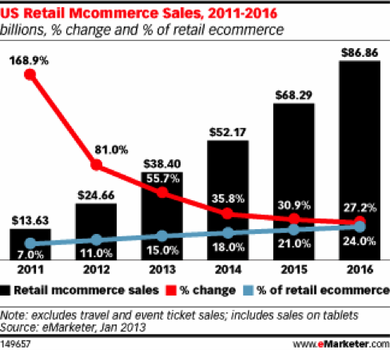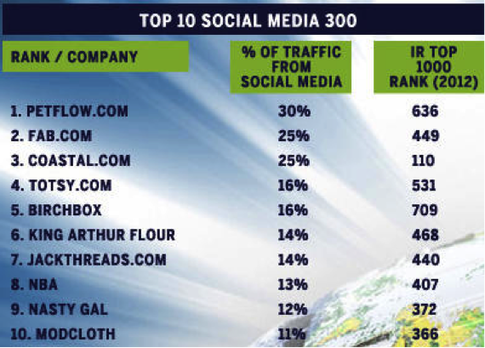
Eleven percent of U.S. e-commerce sales in 2012 —or $25B — came from mobile, according to eMarketer, and they don’t anticipate this trend to revert downward. Yet, many businesses are still lagging behind in their mobile strategy. Unless your business is not selling anything to anyone, or you can’t yet afford it — app developers are in high demand, and supply is not always easy to find — you should probably think about your mobile strategy, whether your company is B2B or B2C.
Most of the laggards are found in B2B companies. But wait a minute, if you are a B2B company, don’t you think your buyers will research your company and products online first? When do buyers and company executives have time to do their research? They are surfing away during long and unproductive meetings, while traveling, or at home watching the kids…Are they lugging their eight pound laptop with them? Probably not. Today’s executive is working on a smartphone or a tablet. If your products and services aren’t easily accessible and readable from these devices, they might just skip to the next supplier.
And what about your sales team? Won’t they benefit from the ability to showcase your products and services to the customer directly from their iPad or tablet? Could you make it a good sales rep/customer conversation enabler?
Don’t feel too bad if your company has not yet fully embraced the mobile world, even Mark Zuckerberg, missed the boat for a little while before having to drastically correct the course. And the new strategy is working: according to Kenshoo, Inc, 20% of Facebook ad revenues in last November and December came from mobile.
There simply is no way around going mobile.
~~~~~~~~~~~~~~~~~~~~~~~~~~~~~~~~~~~~~~~~~~~~~~~~~~~~~~~~~~~~~~~~~~~
Tablets, Smartphones Drive Mobile Commerce to Record Heights
By eMarketer
01/09/2013
Maybe 2012 was the year of mobile after all. US retail mcommerce sales shot up 81% to nearly $25 billion last year, propelled by rapid adoption of tablets and smartphones as shopping devices, according to new estimates from eMarketer.
Mobile devices accounted for 11% of total US retail ecommerce sales in 2012, eMarketer estimates, and further growth is expected to push mobile sales to a 15% share of all US retail ecommerce sales this year.
Mcommerce sales include all purchases made via smartphones, tablets and other mobile devices, excluding sales of travel and event tickets.
eMarketer’s mcommerce forecast reflects a confluence of three trends: first, the expanding number of smartphone shoppers whose behavior affects commerce in all channels; second, the growing number of smartphone buyers who enjoy the immediacy of purchasing through their phone and are expected to generate just over one-third of mcommerce sales this year; and third, the rapid rise in tablet shopping, which will produce the bulk of mcommerce sales over the next four years.
This year, US consumers will spend $24 billion shopping on their tablets, and that figure will nearly double by 2015. Mcommerce sales on smartphones are lower and will grow more slowly, reaching $13.44 billion this year and $24.32 billion by 2016. Purchases on other mobile devices, such as ereaders, will continue to make up a small but steady share of the mcommerce pie.
Read the full article here
Most of the laggards are found in B2B companies. But wait a minute, if you are a B2B company, don’t you think your buyers will research your company and products online first? When do buyers and company executives have time to do their research? They are surfing away during long and unproductive meetings, while traveling, or at home watching the kids…Are they lugging their eight pound laptop with them? Probably not. Today’s executive is working on a smartphone or a tablet. If your products and services aren’t easily accessible and readable from these devices, they might just skip to the next supplier.
And what about your sales team? Won’t they benefit from the ability to showcase your products and services to the customer directly from their iPad or tablet? Could you make it a good sales rep/customer conversation enabler?
Don’t feel too bad if your company has not yet fully embraced the mobile world, even Mark Zuckerberg, missed the boat for a little while before having to drastically correct the course. And the new strategy is working: according to Kenshoo, Inc, 20% of Facebook ad revenues in last November and December came from mobile.
There simply is no way around going mobile.
~~~~~~~~~~~~~~~~~~~~~~~~~~~~~~~~~~~~~~~~~~~~~~~~~~~~~~~~~~~~~~~~~~~
Tablets, Smartphones Drive Mobile Commerce to Record Heights
By eMarketer
01/09/2013
Maybe 2012 was the year of mobile after all. US retail mcommerce sales shot up 81% to nearly $25 billion last year, propelled by rapid adoption of tablets and smartphones as shopping devices, according to new estimates from eMarketer.
Mobile devices accounted for 11% of total US retail ecommerce sales in 2012, eMarketer estimates, and further growth is expected to push mobile sales to a 15% share of all US retail ecommerce sales this year.
Mcommerce sales include all purchases made via smartphones, tablets and other mobile devices, excluding sales of travel and event tickets.
eMarketer’s mcommerce forecast reflects a confluence of three trends: first, the expanding number of smartphone shoppers whose behavior affects commerce in all channels; second, the growing number of smartphone buyers who enjoy the immediacy of purchasing through their phone and are expected to generate just over one-third of mcommerce sales this year; and third, the rapid rise in tablet shopping, which will produce the bulk of mcommerce sales over the next four years.
This year, US consumers will spend $24 billion shopping on their tablets, and that figure will nearly double by 2015. Mcommerce sales on smartphones are lower and will grow more slowly, reaching $13.44 billion this year and $24.32 billion by 2016. Purchases on other mobile devices, such as ereaders, will continue to make up a small but steady share of the mcommerce pie.
Read the full article here


 RSS Feed
RSS Feed